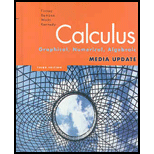
Concept explainers
(a)
To calculate: The value of the function.
(a)
Answer to Problem 8QR
The required value of the function
Explanation of Solution
Given information:
The given function
Calculation:
The given function is
It is given that the value of the function
Thus, for
Hence, the required value of the function
(b)
To calculate: The value of the function.
(b)
Answer to Problem 8QR
The required value of the function
Explanation of Solution
Given information:
The given function
Calculation:
The given function is
It is given that the value of the function
Thus, for
Hence, the required value of the function
(c)
To calculate: The value of the function.
(c)
Answer to Problem 8QR
The required value of the function
Explanation of Solution
Given information:
The given function
Calculation:
The given function is
It is given that the value of the function
Thus, for
Hence, the required value of the function
(d)
To calculate: The value of the function.
(d)
Answer to Problem 8QR
The required value of the function is 0.
Explanation of Solution
Given information:
The given function:
The function to determine:
Formula Used:
Differential formula:
Here
Calculation:
The given function is
From the differential formula rewrite the given function as
It is given that the value of the function
Thus,
Substitute these value in the above function.
Hence, the required value of the function is 0.
Chapter 3 Solutions
Calculus: Graphical, Numerical, Algebraic
Additional Math Textbook Solutions
Elementary Statistics: Picturing the World (7th Edition)
Calculus: Early Transcendentals (2nd Edition)
Algebra and Trigonometry (6th Edition)
Basic Business Statistics, Student Value Edition
A First Course in Probability (10th Edition)
Intro Stats, Books a la Carte Edition (5th Edition)
- Prove 11.1.2arrow_forward39. (a) Show that Σeak converges for each α > 0. (b) Show that keak converges for each a > 0. k=0 (c) Show that, more generally, Σk"eak converges for each k=0 nonnegative integer n and each a > 0.arrow_forward#3 Find the derivative y' = of the following functions, using the derivative rules: dx a) y-Cos 6x b) y=x-Sin4x c) y=x-Cos3x d) y=x-R CD-X:-:TCH :D:D:D - Sin f) Sin(x²) (9) Tan (x³)arrow_forward
 Calculus: Early TranscendentalsCalculusISBN:9781285741550Author:James StewartPublisher:Cengage Learning
Calculus: Early TranscendentalsCalculusISBN:9781285741550Author:James StewartPublisher:Cengage Learning Thomas' Calculus (14th Edition)CalculusISBN:9780134438986Author:Joel R. Hass, Christopher E. Heil, Maurice D. WeirPublisher:PEARSON
Thomas' Calculus (14th Edition)CalculusISBN:9780134438986Author:Joel R. Hass, Christopher E. Heil, Maurice D. WeirPublisher:PEARSON Calculus: Early Transcendentals (3rd Edition)CalculusISBN:9780134763644Author:William L. Briggs, Lyle Cochran, Bernard Gillett, Eric SchulzPublisher:PEARSON
Calculus: Early Transcendentals (3rd Edition)CalculusISBN:9780134763644Author:William L. Briggs, Lyle Cochran, Bernard Gillett, Eric SchulzPublisher:PEARSON Calculus: Early TranscendentalsCalculusISBN:9781319050740Author:Jon Rogawski, Colin Adams, Robert FranzosaPublisher:W. H. Freeman
Calculus: Early TranscendentalsCalculusISBN:9781319050740Author:Jon Rogawski, Colin Adams, Robert FranzosaPublisher:W. H. Freeman
 Calculus: Early Transcendental FunctionsCalculusISBN:9781337552516Author:Ron Larson, Bruce H. EdwardsPublisher:Cengage Learning
Calculus: Early Transcendental FunctionsCalculusISBN:9781337552516Author:Ron Larson, Bruce H. EdwardsPublisher:Cengage Learning





